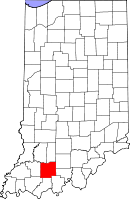 |
| Dubois County, Indiana - Credit Wikipedia |
#10,911
The CDC has today published an update and human health risk assessment for the HPAI and LPAI H7N8 avian flu viruses which were detected late last week on nine poultry farms in Dubois County, Indiana.
As you'll see the assessment and the recommendations are very similar to what we saw last year with the arrival of HPAI H5.
I've only posted about half of the statement, so follow the link to read it in its entirety.
Avian Influenza H7N8 Update
January 19, 2016 -- On January 15, 2016, the United States Department of Agriculture’s (USDA) Animal and Plant Health Inspection Service (APHIS) reported detection of highly pathogenic avian influenza (HPAI) H7N8 virus in a commercial turkey flock in Dubois County, Indiana. Subsequently, APHIS reported detection of low pathogenic avian influenza (LPAI) H7N8 among 8 nearby turkey flocks*. There are nine known subtypes of avian influenza H7 viruses (H7N1, H7N2, H7N3, H7N4, H7N5, H7N6, H7N7, H7N8, and H7N9); most of these have been LPAI viruses. LPAI H7N8 virus has been detected previously in wild bird surveillance in the United States, but this is the first instance of HPAI H7N8 virus detection in poultry.
Avian influenza viruses are classified as either low pathogenic or highly pathogenic depending upon molecular characteristics of the virus and the virus’ ability to cause disease and mortality in chickens in a laboratory setting. Infection of poultry with LPAI viruses may cause no disease or mild illness (such as ruffled feathers and a drop in egg production) and may not be detected. Infection of poultry with HPAI viruses can cause severe disease with high mortality in birds. Both HPAI and LPAI viruses can spread rapidly through poultry flocks. Influenza viruses are constantly changing and LPAI H7 viruses have been known to rapidly evolve into HPAI viruses.CDC Risk Assessment
Human infection with avian influenza viruses is rare, but can occur. Human infections with avian influenza viruses have most often occurred after unprotected close contact with infected birds or the excretions/secretions of infected birds (e.g., droppings, oral fluids). Infected birds shed virus in their saliva, mucous and feces. Human infections with avian influenza viruses can happen when enough virus gets into a person’s eyes, nose or mouth, or is inhaled. This can happen when virus is in the air (in droplets or possibly dust) and a person breathes it in, or when a person touches something that has virus on it then touches their mouth, eyes or nose.
Human infection with avian influenza viruses has not occurred from eating properly cooked poultry or poultry products.
At this time no human infections with avian influenza H7N8 viruses have ever been reported worldwide, however other avian influenza H7 viruses have infected people sporadically, including both LPAI and HPAI H7 viruses. H7 virus infections in people have been associated with a wide range of illness from conjunctivitis only, to influenza-like illness, to severe respiratory illness.
At this time, CDC considers the risk to the general public from these H7 viruses to be low; however, because other avian influenza A H7 viruses have infected people, it is possible that human infections with these viruses could occur. Risk is dependent on exposure. People with close or prolonged unprotected contact with infected birds or contaminated environments are likely to be at greater risk of infection. It is important to note that this is an evolving situation with some uncertainty. The public health risk assessment and associated recommendations may change.
CDC Recommendations
(Continue . . .)















 src="https://blogger.googleusercontent.com/img/b/R29vZ2xl/AVvXsEh4zgoKkY5esDyGDfXmhp5tz0W8H2jEgsRJx2wm9317hpr6CTdO8i4DPQj5mF-OAprw6GVcNt84Pt9Yp5U6XEz5h_pAP7azclFEO7kSUzDjr31IvLdzT01usqHnjVk1bBWsqpHQX6G4AIU/s1600/Photo0783.jpg" />
src="https://blogger.googleusercontent.com/img/b/R29vZ2xl/AVvXsEh4zgoKkY5esDyGDfXmhp5tz0W8H2jEgsRJx2wm9317hpr6CTdO8i4DPQj5mF-OAprw6GVcNt84Pt9Yp5U6XEz5h_pAP7azclFEO7kSUzDjr31IvLdzT01usqHnjVk1bBWsqpHQX6G4AIU/s1600/Photo0783.jpg" />












